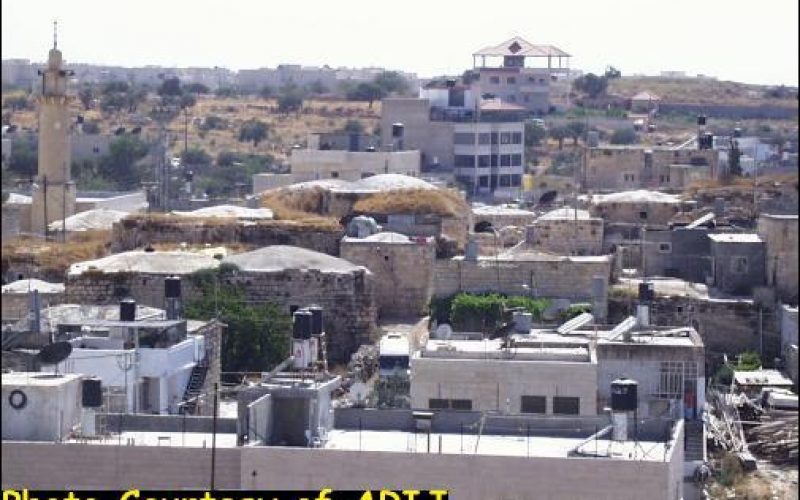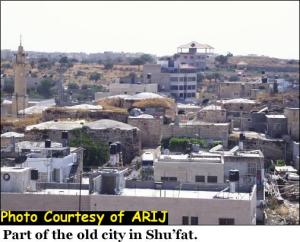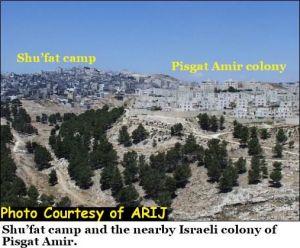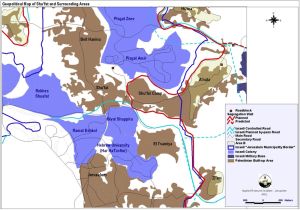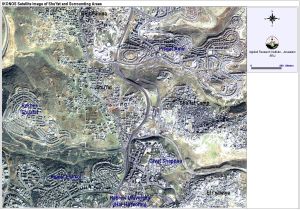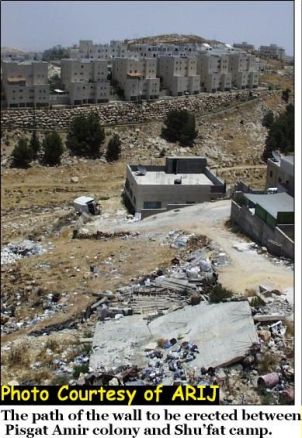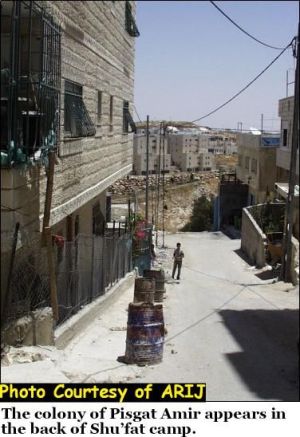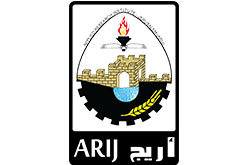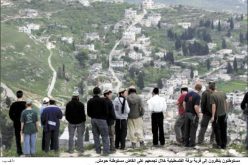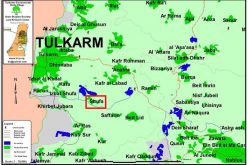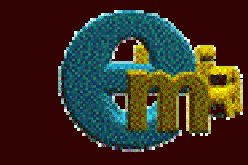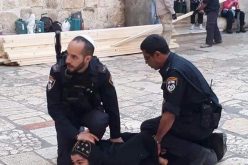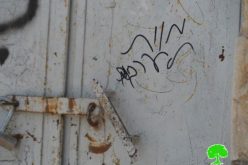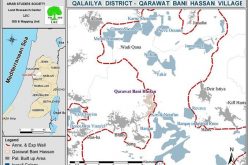Shu'fat city is located about 3 km north of Jerusalem city and houses a population of approximately 15,000 according to Shu'fat Imam, Mr. Mahmoud Abu Khdeir. Shu'fat refugee camp is located east of the city and houses a population of 20,000 according to the General Secretary of the local committee, Mr. Khader Dibs. It is the only Palestinian refugee camp located inside Jerusalem municipal boundaries. The planned path of the Segregation Wall disconnects the camp from Shu'fat and Jerusalem city, while it connects the numerous Israeli settlements in the area around Jerusalem such as Ramot and Rekhes Shu'fat from the west, Pisgat Amir and Pisgat Ze'ev from the north, Kiryat Ta'asirotvat Shappira and Ramat Eshkol from the south. The Segregation Wall has serious, but different impacts on both Palestinian communities.
Background
Shu'fat city is the northern key of Jerusalem where one of Solomon wives (the prophet) chose to live in because she thought it was the best place according to Mr. Mahmoud Abu Khdeir. Tourists used to visit Shu'fat old city where there is a church and other ancient buildings. 4,000-5,000 of the total population belongs to the original families who lived in Shu'fat while the rest are families who emigrated from cities like Hebron, Jerusalem, Ramallah and Beit Hanina.
Refugees of Shu'fat camp originate mainly from 56 Palestinian villages which were expelled in 1948 war. Most of them first lived in Al-Sharaf quarter in the Old City of Jerusalem, where the Jordanian Government provided housing for them after the 1948 war. Soon after the 1967 war, those refugees were expelled by the Israeli authorities for the second time and moved to live in Shu'fat camp which was established in 1965/1966 over an area of 203 dunums from Shu'fat land by The Jordanian Government and the United Nation Refugees and Work Agency in the Near East (UNRWA).
Land ownership
Shu'fat city is situated within Jerusalem municipal boundaries according to the divisions set by Oslo agreements in 1993. It is located inside the village boundary of Al Isawiya which is bounded by the following villages: Beit Hanina from the west, Hizma, 'Anata and El Khan el Ahmar from the east, Et Tur, Esh Sheikh Jarah, Wad el Joz and Lifta from the south. According to Mr. Abu Khdeir, Shu'fat city area is 5,500 dunums and is owned by 6 major clans in the city:
1. Abu Khdeir.
2. Issa.
3. Amouri & Awadallah.
4. Ziada.
5. Mashni.
6. Mohammed (Idies & Shehadah).
Political administration
The area of Shu'fat was included in the Israeli Jerusalem Municipality boundaries after 1967, see Map 1. As a result, residents of Shu'fat city possess Jerusalem ID cards and rely on services provided by the Israeli ministry of social affairs and ministry of interior. Their ID cards give them some advantages compared to the Palestinians of the West Bank; However they are subjected to the continuous Israeli colonization activities including the massive construction of Israeli settlements and the policy of revoking Palestinian Jerusalemites rights living within Jerusalem municipal boundaries.
Map 1: Geopolitical map of Shu'fat and the surrounding areas
The Israeli Master Plan
Mr. Abu Khdeir stated that Jerusalem Municipality started working on a Master plan for Shu'fat city in 1982; Nevertheless, it was not finished until 1999. During this period, residents of Shu'fat were prohibited from building because the municipality considered the old master plan invalid. The land of Shu'fat was redivided without consulting Shu'fat landowners. Out of the 5,500 dunums owned by residents of the village, only 2,000 dunums were included in the new Master plan prepared by Jerusalem municipality. 600 dunums located northwest of Shu'fat city, specifically in the area between the city and the Israeli settlement of Ramot was marked as green areas which cannot be used for building and construction. As a result, residents were prevented from utilizing 4,100 dunums of their land. The land of the refugee camp was not included in the Master plan.
''The plan was theoretically prepared but wasn't practically used'' said Mr. Abu Khdeir. Jerusalem Municipality places many obstacles in the way of Shu'fat residents such as preventing them from building and rejecting any application to issue a building license. Due to this policy (adopted by Jerusalem Municipality against Palestinian Jerusalemites), the number of unlicensed constructions increased due to the increase of population throughout the years and constructions turned to become vertical. According to the local committee of Shu'fat camp, the land designated for natural expansion is limited due to the Israeli colonization activities in the area and the Israeli policies. Buildings which are built without licenses are threatened to be demolished.
-
In 2001 the Israeli government carried out a demolition campaign in such it demolished 17 houses in the area around the camp.
-
Before July 2004, two huge residential buildings and another under construction one in Shu'fat city were marked for demolition by Jerusalem municipality.
Population density
The built-up area of Shu'fat city is approximately 1,225 dunums while the built-up area of the camp and its surrounding areas is approximately 533 dunums (ARIJ database 2004). Considered that the population in the city is �¾ of the population in the refugee camp, the population density in the camp is extremely high reaching to 27 m2 compared to 82 m2 in the city of Shu'fat, see Photo 3.
Map 2: IKONOS image of Shu'fat and surrounding areas
Shu'fat, due to its location near Jerusalem has made it of great importance in the eyes of Palestinians. Due to the construction of the current Israeli Segregation Wall, house rents are increasing as Shu'fat will keep its connections to Jerusalem city. Lately, three Jerusalemite families moved to live in Shu'fat city into one apartment composed of one room for each, noted Mr. Khdeir.
In the beginning, 3,000 people lived in Shu'fat camp which contained 500 housing units that time. Members of the local committee revealed that many generations, including grandfather, sons and children used to live in one housing unit of 112.5 m2 area. They lived in very bad conditions as there were no water, electricity or sewage networks which were first established during the 70ties. The Municipality of Jerusalem takes no responsibility for installing such networks or facilities, as they provide water to the suurounding settlements cut it off from the camp.
Today, the camp houses 2,058 families with a total number of 10,290 registered refugees according to UNRWA. However, the estimated total population is 20,000 due to the non-refugees settling inside the camp and on land leased privately by Shu'fat landowners.. ''People living in other refugee camps located within the West Bank boundaries think of moving out of the camp for better living conditions, while in the case of Shu'fat camp and its location within Jerusalem municipality boundaries, many people want to move to live inside the camp despite the bad living conditions,'' Mr. Khrader Dibs notes.
Many people were emigrating from Jerusalem, especially the Old City, due to their household number and the affordability to buy or rent a house in other quarters of Jerusalem city. Many choose to settle in Shu'fat camp area, where rents are cheaper and they can keep their Jerusalem ID cards. The high population density in the camp results in social problems according to members of the local committee.
Contrary to the situation in Shu'fat, rents are decreasing in the refugee camp due to the construction of the Segregation Wall. One member of the local committee said that two years ago that a resident started building a housing project composed of four apartments. The project, which is now completed, is empty and no one dares to rent. Some families already left the camp looking for other places to live in Jerusalem.
Local leaders without official authority
In 1956, the elections of the local village council in Shu'fat were prohibited by the Israeli authorities. The current village council is therefore appointed by families of Shu'fat. The council has no authority, but are psychologically legitimated by the support and the respect of the local population according to Mr. Abu Khdeir.
The mosque in Shu'fat was built by the support of the local inhabitants and is used in addition to the religious ceremonies for social activities such as summer camps, women and youth activities. This is an important establishment as the youth do not have any other places to spend at, according to Mr. Abu Khdeir.
The UNRWA is now responsible for the Camp affairs. The local committee in the camp was first established in year 1996, following 'Oslo II'' agreement, signed in Washington D.C. in September of 1995, but they had no authority that time. The committee functions were mainly as a bridge between the local inhabitants and different Palestinian communities and international organizations in addition to providing a number of services. They collect money for building schools, halls for social activities and recreational parks. Occasionally, they give students grants for university studies. With the help of a Belgium organization, they could rebuild six houses for needy people.
Israeli settlements
Due to its location inside Jerusalem Municipality boundaries, Shu'fat is seriously subjected to continuous Israeli colonization activities. Four Israeli settlements surround Shu'fat and Shu'fat camp, see Map 1. The settlements are:
1. Givat Shappira (Southeast of Shu'fat)
2. Pisgat Amir (Northeast of Shu'fat)
3. Rekhes Shu'fat (West of Shu'fat)
4. Ramat Eshkol (Southwest of Shu'fat)
The Israeli settlements of Givat Shappira and Ramat Eshkol were established right after Israel expanded the Jerusalem boundaries following the 1967 war. Below is a detailed table of the Israeli settlements surrounding Shu'fat city:
|
Settlement name |
Area and type |
Population |
|
Givat Shappira |
681 dunums – urban |
8,207 |
|
Ramat Eshkol |
1,138 dunums – urban |
31,506 |
|
Pisgat Amir |
2,504 dunums-urban |
n.a |
|
Rekhes Shu'fat |
1,545 dunums-urban |
n.a |
Pisgat Amir is located very close to the camp and many residents now overlook the settlement instead of the forest which covered the area before the settlement was established, see Photo 4 and Photo 5. The settlement is expanding on the expense of Shu'fat lands. and . The settlement is expanding on the expense of Shu'fat lands.
The Segregation Wall
The path of the planned Segregation Wall ensures that the four Israeli settlements mentioned above are situated on the Israeli side and are connected to Jerusalem. The wall, which encompasses the surrounding Israeli settlements, disconnects Shu'fat camp from Shu'fat and Jerusalem cities. In addition to the serious impacts the wall has on the affordibility of services to the camp, but it also affects those who work in Jerusalem city and those living in Palestinian communities located outside the Wall plan and receiving services from communities segregated inside the Wall.
A member of the local committee in Shu'fat camp describes the Wall as the 3rd catastrophe after 1948 and 1967. the current inhabitants were expelled two times already and the Wall might provoke the third. Shu'fat camp represents a problem to the Israeli government due to its location inside Jerusalem Municipality boundaries. Politically administered, it is located within the Municipality boundaries, but the Wall will locate it outside most probably due to its high population density.
The Segregation Wall will affect the educational systems in the camp, as well as the health services, relations between families, the natural territorial expansion and the physiological wellbeing of the people. The committee fears that residents of the camp, on the long run, will loose their Jerusalem ID cards.
Members of the local community think that the Wall is political and away from the Israeli security needs. They revealed that the Mayor of the neighboring Israeli settlement Pisgat Amir, has lately declared that the Wall might bring no-security to the settlement but would provoke militant acts.
Effects of the Segregation Wall
Members of the camp's local committee say that ''as Palestinian refugees living within the Jerusalem Municipality boundaries, they have many problems with Israeli organizations/companies that are supposed to provide them with services as they provide to residents of Jerusalem city. It is for example very difficult to obtain a telephone line in the camp since no telephone network exists. Many have cellular phones even though the service provided for cellular phones is also weak. If the wall is implemented, residents of Shu'fat camp wonder about the fate of their living conditions and the services provided to them, but they'll continue paying taxes (Arnona).
Unemployment issue:-
The unemployment rate is increasing to 40% in the camp according to members of the local committee. A few number of Shu'fat camp residents have Palestinian ID cards,and are currently unemployed. The costruction of the Segregation Wall will certainly increase the unemployment rate dramatically.
Health
The health facilities are good in both Shu'fat and Shu'fat camp according to the local leaders. In Shu'fat city there are four private clinics, and other three clinics in Shu'fat camp and they are linked to Israeli ministry of health. Most of the residents, in both the city and the camp, have free access to these clinics as they have health insurance provided to them as Jerusalemites. In addition, there is one main clinic belonging to the UNRWA in the camp.
The camp lacks ambulance cars and emergency services. Residents of the camp face difficulties with accessing hospitals in Jerusalem in emergency cases. And now that the wall is being implemented, it would be even more difficult for them to access such hospitals due to the obstacles included within Wall constructions. They would have to go around Qalandia area to reach Jerusalem which would take one and a half hour.
Education
According to Jerusalem Municiplaity Master plan, five schools were supposed to be built in Shu'fat, but currently there are only two schools, one for males and the other is for females. Instead of building new schools, Jerusalem municipality uses private companies to run schools for them according to Mr. Abu Khdeir. Buildings belonging to those private companies are normal houses and lack infrastructure. In addition, they are built without building licenses as most of the houses are.
There are three UNRWA schools in Shu'fat camp, two schools for boys and the third is for girls providing an education to 2409 students, see table below
|
Table : Number of students and teachers in UNRWA schools in Shu'fat camp and the number of those affected by the Segregation Wall |
||||||
|
School |
Students |
Students out of Shu'fat Camp |
Teachers |
Teachers out of Shu'fat Camp |
||
|
|
|
|
affected |
|
|
affected |
|
Shu'fat male elementary |
469 |
0 |
0 |
18 |
10 |
10 |
|
Shu'fat male preparatory |
460 |
3 |
3 |
12 |
9 |
8 |
|
Shu'fat female school |
1480 |
178 |
13 |
46 |
34 |
34 |
|
Total (number) |
2409 |
181 |
16 |
76 |
53 |
52 |
|
Source: UNRWA town profile |
||||||
Years before, males and females were situated in the same school building and students needed to make two shifts. Nowadays, there is only one shift in each school with 50 students in each class (overcrowded). However, members of the local committee are afraid that in 2-3 years the same problem will arise!
70% of the teachers do not live in the camp; 52 teachers out of 53 live in the neighboring areas of Shu'fat camp and will be affected by the Wall installations. These would have difficulties in reaching their workplace after the Wall is constructed which again will affect the education system as a whole. Table one above, also shows that the number of females coming from areas outside the camp to study at the UNRWA schools is greater than that of the males. They will have difficulties in reaching their schools due to the construction of the Israeli Segregation Wall. There are 7 private schools close to the camp where some of the residents send their children to. The UNRWA female school only provides education to students till the Tenth grade where an approximate of 89% of the females continues their education in Jerusalem schools according to UNRWA. As for the males, there is only one preparatory school in Shu'fat camp and students looking to continue their education would have to go outside. Reaching schools in Jerusalem every day would be difficult after the construction of the Segregation Wall.
Humanitarian Issue:-
One citizen living in the area around Shu'fat camp tells his story: ''I grew up in the camp along with six sisters and six brothers. I'm married for 16 years now and have six children. I work in a hospital situated west of West Jerusalem. My family is originally from Beit Natif, a Palestinian village located about 17 Km southwest of Jerusalem city. My father's family (Grandparents) was expelled from his home town following the 1948 war and lived in Hebron for one year. He then moved to live in Al-Sharaf quarter in the Old City of Jerusalem. In 1966, he moved again to live in Shu'fat refugee camp where he got married settled in areas around the camp in 1999 looking for better living conditions particularly housing.
He continues to recount: ''To be part of Jerusalem, politically and religiously, is an advantage we have because my family and I own Jerusalem ID cards which provide us with many facilities including health facilities and employment opportunities. The Palestinian ID cards do not make any sense to us because we have no connection with West Bank areas. We did not choose our ID cards and the privileges connected to it, it was forced upon us. What remains, is the obligating associated with it as we have to pay taxes to be part of the system.
The Wall is a catastrophe to all Palestinian people, and mostly to Palestinian Jerusalemites, says the citizen. He notes that his family no connection with Ramallah or Abu Dis or any of the Palestinian communities situated within the PA areas, instead, their connection is completely to Jerusalem: ''We go to Jerusalem for education, work, health facilities, Religious and official matters. Two of my children are handicapped and head to a school for handicapped situated in the Mount of Olives.''
We are tied to Jerusalem through history and relations. The Wall, once completed, it will prevent us from moving freely inside our town! Going to the West Bank will also be difficult. We will be in a big prison! We are living in the dark and more darkness is yet to come'', he concluded.
Prepared by:
The Applied Research Institute – Jerusalem


